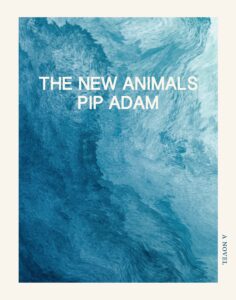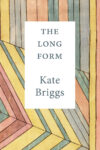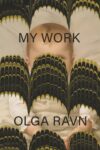
[Dorothy; 2023]
As I made my way through The New Animals and its roll call of generally unpleasant characters, it came as somewhat of a surprise to learn that Adam considers the novel a love song to hairdressing. “It saved my life in a lot of ways,” she says in an interview with Real Pants, referring to her time cutting hair. “The greatest thing hairdressing gave my writing was . . . it is super hard to touch someone’s head, to run your hands through their hair and then think, ‘This person and I are so different.’” And this duality in Adam’s writing—carefully crafted, contemptible characters juxtaposed with a depthless empathy for them and their questionable choices—caused this reader to pause: It’s not Adam judging these people, it’s me. Adam is inviting her readers to take a closer look: Why are they (why are we) like this? The answer, in a word, is work. Work makes us good, and work makes us bad. It breaks us, destroys us; it brings us together, and it sustains. We cut hair, sit in cubicles, create content, sell houses, make patterns, and not even for ourselves! For others. We are selfish and selfless. And we do all this pretty much until the day we die. According to Adam, if you want to write about the modern human, you must write about her at work.
The second of her four novels, The New Animals was first published in 2017 by Te Herenga Waka University Press, and has recently been republished by Dorothy, a publishing project. In reviews, Adam has been described as “out-Hemingwaying Hemingway.” Her prose is characterized by its lack of irony, sometimes even lack of narrative—pages go by as someone holds up a white t-shirt until their arms begin to sear with pain, for instance. To Adam, plotless, richly internal existence is the weirdest, most fascinating thing worth writing about. In this sense, the book’s back cover blurb justifiably compares The New Animals to Virginia Woolf’s To the Lighthouse.
Unexpectedly, Adam satisfies her penchant for the mundane by situating The New Animals in the fast-paced trenches of the New Zealand fashion industry in the year 2016. We walk into a scene with Carla, a freelance hairdresser and the novel’s protagonist, on her way to a meeting with a clothing label. “Carla was old now,” we learn, “comfortable and smart and quiet, but not weirdly . . . what fell from her as she walked into these meetings, was that she had seen it and made it and broken it and been broken by it all before.” This fashion label is owned by the rich up-and-comers Tommy, Cal, and Kurt, millennials to Carla’s Gen-X. The nod to Carla’s age (forty-three) is pejorative, but also indicates what makes her admirable, and sometimes inscrutable, especially to these young men. Whereas they are the “new sincere, the anti-irony,” true lovers of unicorns that “really say something about the pre-apocalptic mess they were all drowning in,” Carla is barely contained contempt, silent mocking laughter. Adam glides between Carla’s and many other consciousnesses over the course of a single night in Auckland: Tommy, the label’s nominal leader (merely because his father is footing the label’s expanding bills); Sharona, another industry old-timer; Duey, Sharona and Carla’s long-time friend from their early fashion days; and Elodie, the young makeup artist regarded suspiciously by the others for being genuinely nice. The prose becomes a tapestry in its own right, threading itself into and out of these perspectives, well, seamlessly.
Beyond its simple plot—Tommy, ignoble leader, has haphazardly scheduled a label photoshoot early the next morning, before the required clothing samples have even arrived from overseas, and screwed over everyone but himself—the novel’s focus is the quotidian nature of work. The esoteric skillsets, quiet alliances, small graces, unspoken betrayals, subtextual hatreds that occur daily in the lives of all those who have entered the modern pact of civilization: the workplace. These humdrum interactions prop up Adam’s prose, which is both unadorned and breathtaking, like in this scene between Sharona and Carla at the start of the night:
Sharona and Carla hugged, and Carla looked at the table. . . . There was a 10 x 12 print of Brett Anderson wearing a leather jacket, shirtless, with a silver, huge-linked chain around his neck. . . . Next to that was a publicity still from Poison Ivy. A seventeen-year-old Drew Barrymore stood outside in front of a rack of autumn-hued dresses. . . . She wore blue denim jeans cut off to shorts and a black biker jacket, and under that a sheer mauve top and a lace bra.
“Leather,” Carla said.
Sharona gave a slight huffy laugh and nodded.
“And lace,” said the sample machinist, and they all smiled at one another.
Carla wound one of the photographs round so it faced her, then the other. “That,” she said, pointing from one image to the other, “is going to take some range building.”
Everyone laughed like it was a light joke but they all knew that it said something deeply humiliating about Tommy and Kurt and Cal.
Adam deftly evokes the swift and knowing bond between the women looking down cynically at the male gaze-ified vision of beauty and commercial “art”; the social and professional hierarchies of these meetings; the sarcastic laughter and lighthearted jabs; the silent acknowledgment that some people know how to do their jobs, understand cultural references (Anderson was known for his androgyny, Barrymore as ingenue femme), while others do not. The novel feeds on the nutrient-dense, fetid compost of such workplace dynamics. Oh, the things that can only be whispered sideways to a knowing colleague, or thought privately in the dungeon of the mind. The human psyche, whether on the clock or off, becomes a room of funhouse mirrors facing external animus and internal self-loathing into infinity. In short: work is a drag.
Each character has a laundry list of regret, shame, and burn-out energy that has ruined them—even young and hopeful Tommy, who thoughtlessly runs his employees into the ground and resents his rich father for believing in him so wholeheartedly. Sharona lives in the guilt of having abandoned her now-teenaged daughter at six weeks old. Elodie sleeps with just about everyone involved with the label, from Kurt to Tommy to Carla. In one hopeful gesture of empathy and goodness, Carla adopts a female dog named Doug, abandoned by a fellow industry worker. But she destroys any warm-hearted feelings we might develop for her by regularly locking Doug in her bathroom and refusing to take her on walks. By the time we meet Doug, she has taken to feral destruction of Carla’s apartment, and honestly, who can blame her? Humans, it seems, are a rotten species all around.
If something could save any of these people, it would be precious connection, but the two closest characters, Duey and Carla, experience only embroiled tensions. Carla reveals their lost intimacy when she tastelessly makes fun of Duey’s sexuality to their face. Friends for thirty years, Carla was gone for ten, so they recalculate their time together down to twenty. Carla now “wind[s] [Duey] up with jokes about sex and the people Duey had sex with, just to bring Duey down to size. Maybe. Though Carla wasn’t like that . . . she hassled Duey to show she knew something about her, something from way back, trying to find the path back to way back.” Carla not only misgenders Duey (who came out as a trans man in Carla’s absence), but also demeans their private life under a pathetic guise of closeness. There is no path back to way back. But this night is not even a dramatic blowout for their friendship—even worse, it reveals their friendship to be a soft ember that dies as the night gets colder and darker.
Adam’s characters sift their surroundings for something that lasts, and come up empty-handed. And how could they not? This is the world we have fashioned. Mercurial styles, friendships, and purpose come and go. This concept is not lost on Carla, Sharona, and Elodie: the only thing that seems to last forever is the indestructible trash we accumulate. The same is true of the fashion industry—of the one hundred billion garments made each year, 87 percent will end up in landfills, where it will take, for some synthetic fibers, hundreds of years to decompose. Human-caused ruination inflicted upon the natural world, in The New Animals, bobs up in the worlds we fabricate socially with one another.
But the novel takes a sharp left turn in its last third, when Adam turns her attention to the younger minor character of Elodie who, we learn, is the only one trying to escape this empty livelihood. Convinced that Doug the abused dog “remembers” the route of escape, she breaks into Carla’s apartment, bites Doug (literally) into submission, and the two flee—free and unfettered animals—into the night, toward the ocean. From here on out, we stay with Elodie’s perspective. Heavy in symbolism of water as baptism as rebirth, these scenes follow Elodie as she swims far out into the ocean, mentally willing herself to physically transform into a creature built for the new world climate change is precipitating. Elodie becomes a creature who can meet the rising sea levels, and fashion an island fit for the new animals humans will have to become if we are to survive.
We learn that Elodie’s promiscuity was transactional, her search for information and wisdom, especially from Carla, the elder who had escaped once before. Elodie’s “suspicious” niceness was just her listening for “hot tips” about where and how to live. What had Carla found, what did she know? After their initial hook-up, Carla speaks vaguely of the ocean, an island that no one else has seen. And, as she swims for her murky destination, Elodie imagines building new neighborhoods, fresh land developments, harvestable real estate, ruling mayorships. She encounters an octopus, whales, a shipwreck, dead bodies; eventually even Doug falls back, perhaps dying or simply giving up. Elodie compels herself to outpace, to outlast them all; her skin begins to lose its definition and peel away. Elodie, shedding, is singular, utterly alone in her mission.
Elodie’s quest, given the smaller, nuanced sections that make up the first two-thirds of the novel, is a grandiose Renaissance painting in a world otherwise made up of meticulous pointillism. This is surely intentional on Adam’s part, but the section reads as unconsidered, similar to Tommy’s unnecessary rush to photograph pieces that have not yet arrived. The collapse of Carla’s and Duey’s friendship in its own right seems to capture the larger downfall of humanity in a satisfying, mesmerizing way. So who are the new animals here? Elodie, the lone swimmer who will reconstruct the same world that has already led to failure (“. . . [s]he was the coloniser of the new land—she was prime minister, developer, real estate agent.”), or Carla and Duey, two organisms of the same species, evolutionarily fashioned for community, but who, over the course of decades, can’t seem to stay together? Elodie—loveless, companionless, with her newfound empty wisdom—is swimming towards a sterile fate. We know her colonizing ways all too well, seen their transformative effects on Carla and Duey. We see the creatures we have already become.
Jennifer Lynn Christie is a writer and user experience designer living in Bloomington, IN. Her reviews have appeared at Entropy, Denver Quarterly, Newfound, and Full Stop. Her stories have appeared in Best of the Net, Heavy Feather Review, Always Crashing, and elsewhere.
This post may contain affiliate links.







